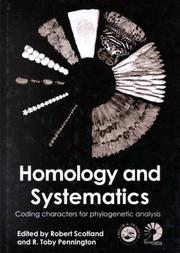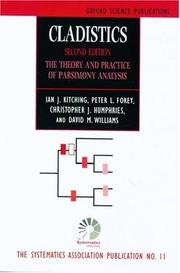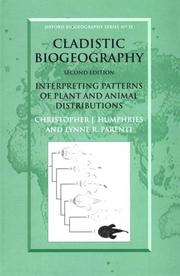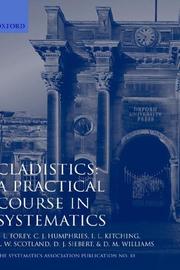| Listing 1 - 10 of 26 | << page >> |
Sort by
|
Book
ISBN: 9788021077126 8021077123 9788021063631 Year: 2014 Publisher: Brno
Abstract | Keywords | Export | Availability | Bookmark
 Loading...
Loading...Choose an application
- Reference Manager
- EndNote
- RefWorks (Direct export to RefWorks)
The book presents an overview and brief description of the most frequent methods of phylogenetic inference. It provides basic information on underlying assumptions of these methods, their advantages and disadvantages, and differences between them. The text is supposed to help readers to make informed decisions in choosing an optimal approach for solving a given problem and for a given type of data as well as in correct interpretation of results. The book begins with an overview of the types of data for phylogenetic analysis, databases and sequence alignment, followed by methods of parsimony, evolutionary models, distance methods, likelihood, Bayesian inference, testing hypotheses, and comparing phylogenies. A separate chapter is focused on phylogenetic methods based on morphological data. The final part deals with the theory of coalescent which is essential for an array of population genetic analyses including new approaches to phylogeography.
Cladistic analysis. --- Cladistic analysis --- Cladism --- Cladistic method --- Cladistic taxonomy --- Cladistics --- Cladograms --- Phylogenetic systematics --- Phylogenetic taxonomy --- Taxonomy, Cladistic --- Taxonomy, Phylogenetic --- Biology --- Branching processes --- Phylogeny --- Data processing. --- Classification
Book
ISBN: 1316688933 1316689182 1316689433 1316689689 1316690431 1316338797 1316687430 9781316338797 9781316690437 9781107117648 110711764X Year: 2016 Publisher: New York, New York
Abstract | Keywords | Export | Availability | Bookmark
 Loading...
Loading...Choose an application
- Reference Manager
- EndNote
- RefWorks (Direct export to RefWorks)
Willi Hennig (1913-76), founder of phylogenetic systematics, revolutionised our understanding of the relationships among species and their natural classification. An expert on Diptera and fossil insects, Hennig's ideas were applicable to all organisms. He wrote about the science of taxonomy or systematics, refining and promoting discussion of the precise meaning of the term 'relationship', the nature of systematic evidence, and how those matters impinge on a precise understanding of monophyly, paraphyly, and polyphyly. Hennig's contributions are relevant today and are a platform for the future. This book focuses on the intellectual aspects of Hennig's work and gives dimension to the future of the subject in relation to Hennig's foundational contributions to the field of phylogenetic systematics. Suitable for graduate students and academic researchers, this book will also appeal to philosophers and historians interested in the legacy of Willi Hennig.
Cladistic analysis. --- Hennig, Willi, --- Cladism --- Cladistic method --- Cladistic taxonomy --- Cladistics --- Cladograms --- Phylogenetic systematics --- Phylogenetic taxonomy --- Taxonomy, Cladistic --- Taxonomy, Phylogenetic --- Biology --- Branching processes --- Phylogeny --- Classification --- Henning, Emil Hans Willi,
Book
ISBN: 9781138332935 1138332933 9780429446276 0429446276 9780429821196 0429821190 9780429821219 0429821212 9780429821202 0429821204 Year: 2020 Publisher: Boca Raton CRC Press Taylor & Francis Group
Abstract | Keywords | Export | Availability | Bookmark
 Loading...
Loading...Choose an application
- Reference Manager
- EndNote
- RefWorks (Direct export to RefWorks)
"Nearly 300 clades - lineages of organisms - will be defined by reference to hypotheses of phylogenetic history rather than by taxonomic ranks and types. This volume will document the Real World uses of PhyloCode and will govern and apply to the names of clades, while species names will still be governed by traditional codes"--
Cladistic analysis. --- Phylogeny --- Nomenclature. --- Cladistic analysis --- Animal phylogeny --- Animals --- Phylogenetics --- Phylogeny (Zoology) --- Biology --- Evolution (Biology) --- Cladism --- Cladistic method --- Cladistic taxonomy --- Cladistics --- Cladograms --- Phylogenetic systematics --- Phylogenetic taxonomy --- Taxonomy, Cladistic --- Taxonomy, Phylogenetic --- Branching processes --- Nomenclature --- Classification --- Evolution. Phylogeny --- Animal systematics, taxonomy, nomencl.
Book
ISBN: 1108613985 1316276252 1108605125 9781108605120 9781316276259 9781107111721 1107111722 9781107529366 Year: 2018 Publisher: Cambridge
Abstract | Keywords | Export | Availability | Bookmark
 Loading...
Loading...Choose an application
- Reference Manager
- EndNote
- RefWorks (Direct export to RefWorks)
A. W. F. Edwards is one of the most influential mathematical geneticists in the history of the discipline. One of the last students of R. A. Fisher, Edwards pioneered the statistical analysis of phylogeny in collaboration with L. L. Cavalli-Sforza, and helped establish Fisher's concept of likelihood as a standard of statistical and scientific inference. In this book, edited by philosopher of science Rasmus Grønfeldt Winther, Edwards's key papers are assembled alongside commentaries by leading scientists, discussing Edwards's influence on their own research and on thinking in their field overall. In an extensive interview with Winther, Edwards offers his thoughts on his contributions, their legacy, and the context in which they emerged. This book is a resource both for anyone interested in the history and philosophy of genetics, statistics, and science, and for scientists seeking to develop new algorithmic and statistical methods for understanding the genetic relationships between and among species both extant and extinct.
Population genetics --- Genetics --- Cladistic analysis. --- Mathematical models. --- Edwards, A. W. F. --- Cladism --- Cladistic method --- Cladistic taxonomy --- Cladistics --- Cladograms --- Phylogenetic systematics --- Phylogenetic taxonomy --- Taxonomy, Cladistic --- Taxonomy, Phylogenetic --- Biology --- Branching processes --- Phylogeny --- Biomathematics --- Classification --- Edwards, Anthony William Fairbank,

ISBN: 0748409203 Year: 2000 Publisher: London Taylor and Francis
Abstract | Keywords | Export | Availability | Bookmark
 Loading...
Loading...Choose an application
- Reference Manager
- EndNote
- RefWorks (Direct export to RefWorks)
Systematics. Taxonomy. Nomenclature --- 57.065 --- 57.017 --- Cladistic analysis --- -Homology (Biology) --- Anatomy, Comparative --- Biology --- Evolution (Biology) --- Morphology --- Phylogeny --- Cladism --- Cladistic method --- Cladistic taxonomy --- Cladistics --- Cladograms --- Phylogenetic systematics --- Phylogenetic taxonomy --- Taxonomy, Cladistic --- Taxonomy, Phylogenetic --- Branching processes --- Phylogenetic classification systems --- Biological characteristics. Life histories --- Methodology --- Classification --- Homology (Biology). --- Methodology. --- homology --- phylogeny --- systematics --- 57.017 Biological characteristics. Life histories --- 57.065 Phylogenetic classification systems --- Homology (Biology)
Book
ISBN: 0231045743 Year: 1981 Publisher: New York, NY : Columbia University Press,
Abstract | Keywords | Export | Availability | Bookmark
 Loading...
Loading...Choose an application
- Reference Manager
- EndNote
- RefWorks (Direct export to RefWorks)
SYS General Systematics --- cladistics --- general systematics --- vicariance biogeography --- Biogeography --- Biology --- Cladistic analysis --- Cladism --- Cladistic method --- Cladistic taxonomy --- Cladistics --- Cladograms --- Phylogenetic systematics --- Phylogenetic taxonomy --- Taxonomy, Cladistic --- Taxonomy, Phylogenetic --- Biosystematics --- Organisms --- Systematic biology --- Systematics (Biology) --- Taxonomy (Biology) --- Areography (Biology) --- Geographical distribution of animals and plants --- Species --- Species distribution --- Classification --- Geographical distribution --- Branching processes --- Phylogeny --- Taxonomists --- Geography
Book
ISBN: 9780521755962 9780511974076 0521755964 9780511932830 0511932839 9780511927645 0511927649 1107216419 1282917455 9786612917455 0511931492 0511974078 0511925107 0511930151 9781107216419 9781282917453 6612917458 9780511931499 9780511925108 9780511930157 Year: 2010 Publisher: Cambridge Cambridge University Press
Abstract | Keywords | Export | Availability | Bookmark
 Loading...
Loading...Choose an application
- Reference Manager
- EndNote
- RefWorks (Direct export to RefWorks)
"The evolutionary history of species is traditionally represented using a rooted phylogenetic tree. However, when reticulate events such as hybridization, horizontal gene transfer or recombination are believed to be involved, phylogenetic networks that can accommodate non-treelike evolution have an important role to play. This book provides the first interdisciplinary overview of phylogenetic networks. Beginning with a concise introduction to both phylogenetic trees and phylogenetic networks, the fundamental concepts and results are then presented for both rooted and unrooted phylogenetic networks. Current approaches and algorithms available for computing phylogenetic networks from different types of datasets are then discussed, accompanied by examples of their application to real biological datasets. The book also summarises the algorithms used for drawing phylogenetic networks, along with the existing software for their computation and evaluation. All datasets, examples and other additional information and links are available from the book's companion website at www.phylogenetic-networks.org"-- "In the first part of this book we give an introduction to basic concepts from graph theory and systematics (Chapter 1). We briefly discuss the problem of aligning molecular sequences (Chapter 2) and give a more detailed introduction to the computation of phylogenetic trees from aligned sequences and distances (Chapter 3). Finally, we give a brief introduction to the computation of phyloge-netic networks, which also serves as an overview for the material presented in the second and third parts of the book (Chapter 4). Chapters 2 and 3 are provided for the sake of completeness and reference. They can be skipped by readers who have a basic knowledge of phylogenetic "--
Evolution. Phylogeny --- Cladistic analysis --- Phylogeny --- Data processing --- Mathematics --- Phylogeny. --- Data processing. --- Mathematics. --- Animal phylogeny --- Animals --- Phylogenetics --- Phylogeny (Zoology) --- Biology --- Evolution (Biology) --- Cladism --- Cladistic method --- Cladistic taxonomy --- Cladistics --- Cladograms --- Phylogenetic systematics --- Phylogenetic taxonomy --- Taxonomy, Cladistic --- Taxonomy, Phylogenetic --- Branching processes --- Classification --- Genetic Phenomena. --- Cladistic analysis - Data processing --- Cladistic analysis - Mathematics --- Genetic Phenomena --- Biological evolution

ISBN: 0198501382 0198501390 9780198501381 9780198501398 Year: 1998 Volume: 11 Publisher: Oxford Oxford University Press
Abstract | Keywords | Export | Availability | Bookmark
 Loading...
Loading...Choose an application
- Reference Manager
- EndNote
- RefWorks (Direct export to RefWorks)
57.065 --- #WPLT:syst --- 57.065 Phylogenetic classification systems --- Phylogenetic classification systems --- Branching processes --- character coding --- cladistic analysis --- glossaries --- Cladistic analysis --- Cladistic analysis. --- Cladism --- Cladistic method --- Cladistic taxonomy --- Cladistics --- Cladograms --- Phylogenetic systematics --- Phylogenetic taxonomy --- Taxonomy, Cladistic --- Taxonomy, Phylogenetic --- Biology --- Phylogeny --- Classification

ISBN: 0198548184 9780198548188 Year: 1999 Publisher: Oxford: Oxford university press,
Abstract | Keywords | Export | Availability | Bookmark
 Loading...
Loading...Choose an application
- Reference Manager
- EndNote
- RefWorks (Direct export to RefWorks)
Analyse cladistique --- Cladistic analysis --- Biogeography --- Biogeography. --- Cladistic analysis. --- Biogéographie --- Cladism --- Cladistic method --- Cladistic taxonomy --- Cladistics --- Cladograms --- Phylogenetic systematics --- Phylogenetic taxonomy --- Taxonomy, Cladistic --- Taxonomy, Phylogenetic --- Biology --- Branching processes --- Phylogeny --- Areography (Biology) --- Geographical distribution of animals and plants --- Species --- Species distribution --- Geography --- Classification --- Geographical distribution

ISBN: 0198577672 0198577664 Year: 1992 Volume: 10 Publisher: Oxford Clarendon
Abstract | Keywords | Export | Availability | Bookmark
 Loading...
Loading...Choose an application
- Reference Manager
- EndNote
- RefWorks (Direct export to RefWorks)
Analyse cladistique --- -Cladistic analysis --- 57.065 --- Branching processes --- Phylogenetic classification systems --- 57.065 Phylogenetic classification systems --- Biology --- Cladistic analysis --- Cladism --- Cladistic method --- Cladistic taxonomy --- Cladistics --- Cladograms --- Phylogenetic systematics --- Phylogenetic taxonomy --- Taxonomy, Cladistic --- Taxonomy, Phylogenetic --- Phylogeny --- Biosystematics --- Organisms --- Systematic biology --- Systematics (Biology) --- Taxonomy (Biology) --- Taxonomists --- Classification --- Cladistic analysis. --- Classification. --- classification --- Biogeography --- Biologie --- classification. --- CLADISTICS --- PHYLOGENY --- TAXONOMY --- TEXTBOOKS --- Cladistique
| Listing 1 - 10 of 26 | << page >> |
Sort by
|

 Search
Search Feedback
Feedback About UniCat
About UniCat  Help
Help News
News